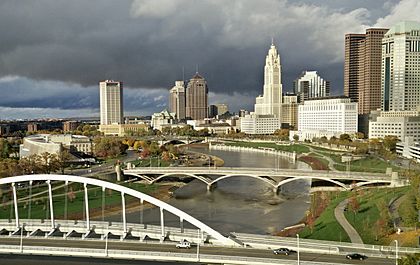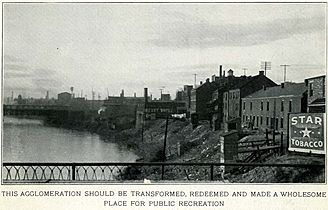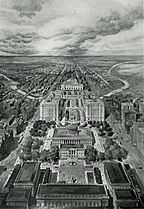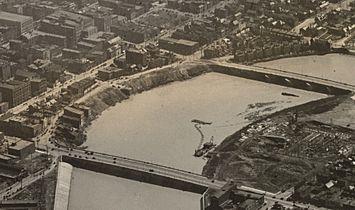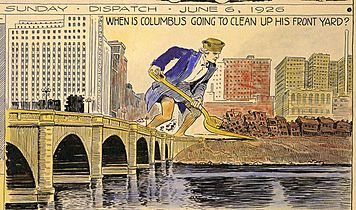Columbus Civic Center (Ohio) facts for kids
The Columbus Civic Center is a special area in Downtown Columbus, Ohio. It's a collection of important government buildings, museums, and open parks. This area is found along the Scioto Mile recreation spot and used to be right on the banks of the Scioto River.
Some of the main buildings here include Columbus City Hall, the Ohio Judicial Center, and Central High School. Central High School is now home to the COSI science museum. You'll also find the Joseph P. Kinneary United States Courthouse and the old police headquarters. The area also features modern bridges like the Discovery Bridge, the Rich Street Bridge, and a new Main Street Bridge. Other nearby buildings like the LeVeque Tower and the Ohio Statehouse are sometimes considered part of the civic center too.
The idea for this riverfront civic center came from the "City Beautiful movement" in 1908. This movement aimed to make cities more beautiful and organized. A big flood in 1913 destroyed many buildings along the river. This sad event actually gave the city a chance to rebuild the area exactly as planned. Important buildings, bridges, and a strong wall were built between 1917 and 1934. These structures show different styles like Neoclassical, Renaissance Revival, and Art Deco. In 1988, this area was suggested to be added to the National Register of Historic Places. This list recognizes important historical places in the United States.
Contents
What is the Columbus Civic Center Historic District?
The Columbus Civic Center Historic District is a special area that includes most of the civic center. It's recognized for its history and architecture.
This district includes several important buildings:
- Central High School (built in 1924)
- Columbus City Hall (built in 1928)
- The old Central Police Station (built in 1928)
- The Ohio Judicial Center (built in 1933)
- The Joseph P. Kinneary United States Courthouse (built in 1934)
The district also includes the strong retaining wall along the river. This wall stretches between Broad and Town Streets. Some older bridges were part of the district, but they have been replaced by newer ones like the Discovery Bridge and the Rich Street Bridge.
The city of Columbus suggested this area for the National Register of Historic Places in the late 1980s. It was considered important because of its role in city planning, engineering, government, and transportation. Its unique building styles, like Art Deco and Neoclassical, also made it special. Even though it was approved as eligible in 1988, it was never officially added to the list.
How the Civic Center Was Built
The story of the Columbus Civic Center began with a big idea to make the city more beautiful.
Early Plans for a Beautiful City
When Columbus was first founded, there weren't many planned green spaces downtown. Only areas around the Ohio Statehouse and the Carnegie Library were set aside. In 1908, a plan called the "Columbus Plan" suggested creating more green spaces and public walkways. It also wanted to clean up the riverfront.
At that time, the riverfront was filled with factories, coal yards, and old buildings. Many buildings were even dumping sewage directly into the Scioto and Olentangy rivers. The city wanted to clean this up to make a better impression for visitors. Especially for those arriving from the west on the National Road.
The Great Flood and New Opportunities
The 1908 plan imagined a civic center along the river. It aimed to connect both sides of the river with the nearby Capitol Square. The plan called for classic-looking buildings surrounded by open spaces and parks. However, progress was slow.
Then, in 1913, a huge flood hit Columbus. This flood destroyed many buildings and bridges along the river. While it was a disaster, it also gave the city a chance to rebuild. They could now create the civic center they had planned. This time, they added flood control measures like a strong retaining wall and a low dam. The civic center area was even made two to three times larger than first planned.
Building the Civic Center
From 1917 to 1922, the Broad Street and Town Street Bridges were built. These bridges had a similar Neoclassical style. The strong retaining wall between the bridges was also built during this time. It is still standing today.
In 1921, the old Columbus City Hall burned down. This meant a new city hall could be built as part of the new civic center. In 1923, a famous architect named Frank Packard started working on a new civic center plan. He brought together many architects to help. Sadly, Packard passed away later that year before any of the main buildings were constructed.
Even without Packard, the city continued with the plan. They decided to build a police station and state offices there. The federal government also moved its post office and courthouse to the new civic center. In 1924, Central High School opened. It was the first building built along the river since the 1908 plan. Its stone design helped connect the government buildings on the east side with the school on the west. The main government buildings were then built between 1926 and 1934. Since then, other government offices and museums have also been added to the civic center area.
Gallery


